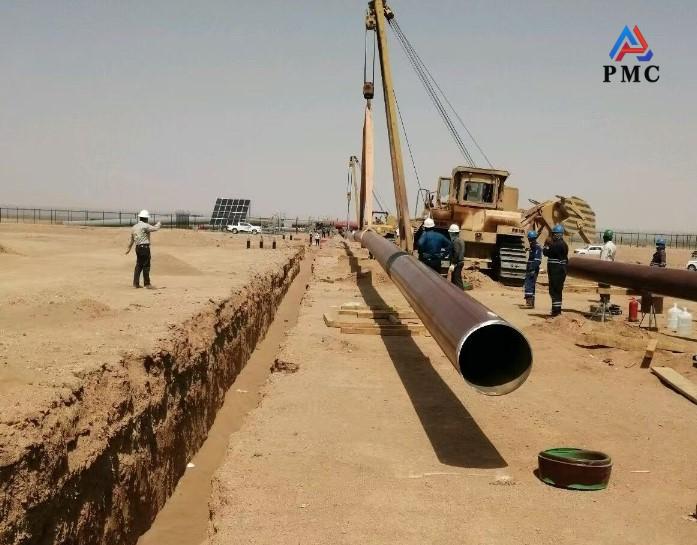
Can Seamless Pipes be Buried Underground?
Can seamless pipes be buried underground? Of course, seamless steel pipes can be buried underground. In fact, they are widely used in underground long-distance pipelines in the fields of oil, natural gas, and water conservancy. However, underground use places very strict requirements on seamless steel pipes because the underground corrosive environment is its biggest threat.
Why do buried steel pipes need special protection?
The soil environment is complex and diverse, and is a hotbed for steel pipe corrosion. The main corrosion factors include:
Soil electrolyte: The moisture and salt in the soil will form an electrolyte, which will cause electrochemical corrosion on the surface of the steel pipe.
Soil pH: Acidic or alkaline soils accelerate corrosion.
Stray current: Stray current generated by urban underground pipelines, cables, etc. will cause steel pipes to act as anodes and accelerate corrosion.
Key corrosion protection measures
To ensure the service life of seamless pipes after burial, two or more of the following anti-corrosion protection measures must be taken:
1. External anti-corrosion coating
This is the most basic and direct way of protection, just like putting a layer of "anti-corrosion coat" on the steel pipe to isolate it from external corrosive media.
Three-layer polyethylene (3PE) anti-corrosion layer: This is one of the most commonly used and best-performing anti-corrosion coatings. It consists of a three-layer structure:
Base layer: epoxy powder (FBE), provides excellent adhesion and anti-corrosion performance.
Middle layer: adhesive, firmly bonding the bottom layer and the outer layer.
Outer layer: Polyethylene (PE), provides strong mechanical protection and weather resistance.
Fusion bonded epoxy powder (FBE): Suitable for occasions with high requirements for corrosion resistance. The coating has uniform thickness and strong adhesion, but its resistance to mechanical damage is slightly inferior to 3PE.
Coal tar epoxy (EAC): A traditional anti-corrosion coating with lower cost, but its environmental performance and anti-corrosion effect are not as good as 3PE.

2. Cathodic protection
This is an electrochemical anti-corrosion technology that prevents corrosion by changing the potential of the steel pipe. It is usually used in combination with external anti-corrosion coating to form a double protection.
Sacrificial anode method: connect metals with a more negative potential than the steel pipe (such as magnesium and zinc blocks) to the steel pipe. These metals will act as "sacrificial anodes" and corrode first, thereby protecting the steel pipe itself.
Impressed current method: Through an external DC power supply, the auxiliary anode in the soil is energized to form a protective current, which keeps the steel pipe in a cathode state and thus protects it from corrosion.
When is it "must" to use seamless pipes for burial?
|
System type |
Work pressure |
Regulatory terms |
Burial requirements |
|
Fire water supply |
>1.6 MPa |
GB 50974-2014 8.2.4 |
Seamless steel pipe is recommended (>1.2 MPa is optional, >1.6 MPa is preferred) |
|
Fire water supply |
>1.6 MPa and DN≥300 |
GB 50974-2014 8.2.5 |
Grooved joint ≤1.6 MPa, if the limit is exceeded, flange/weld → seamless steel pipe |
|
Low pressure steam/hot water |
<1.6 MPa and <200 ℃ |
GB 50041-2008 18.4.1 |
Seamless steel pipes can be used (preferably over welded steel pipes) |
|
Direct buried heat |
Any pressure |
GB 50041-2008 18.4.1 |
Seamless steel pipes should be used (not through trenches or directly buried) |
Conclusion: As long as the pressure is greater than 1.2 MPa, or it is a direct buried thermal or fire protection overpressure section, the regulations give priority to or force the use of seamless steel pipes.
Typical scenarios and precautions for underground applications
1. applicable scenarios
High-pressure fluid transportation: such as urban high-pressure natural gas pipelines (pressure ≥ 4MPa), industrial high-pressure steam pipelines, and oilfield gathering pipelines;
Crossing complex environments: For example, buried pipelines crossing railways and rivers need to rely on the high strength of seamless steel pipes to resist external impacts;
Scenarios with high safety requirements: such as hazardous media transportation pipes in chemical parks. Seamless pipes have no weld defects, reducing the risk of leakage.
2. Precautions
Avoid use in highly corrosive soils (such as acidic soils with a pH value less than 4 and coastal mudflats containing large amounts of chloride ions). If use is unavoidable, upgrade the anti-corrosion solution (such as alloy seamless pipes + multi-layer anti-corrosion).
The buried depth must comply with regulations (e.g. ≥0.7m below the roadway, ≥0.5m below the non-roadway) to prevent ground loads from damaging the pipeline.
Regular inspection: Use pipeline corrosion detection (such as ultrasonic testing and magnetic flux leakage testing) to check the condition of the pipe body and anti-corrosion layer to extend the service life.
Read more: Is Galvanized Steel Pipe Buried Underground Mainly For Corrosion Protection?


